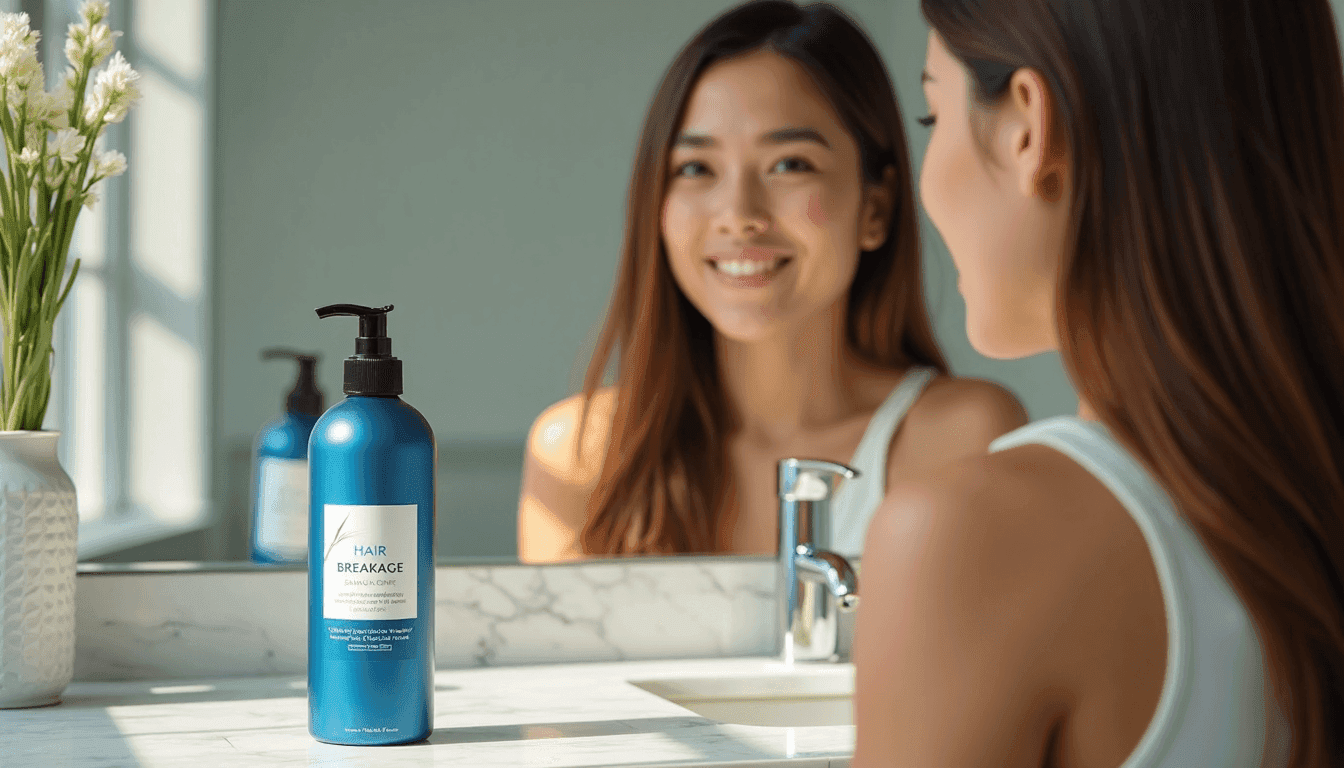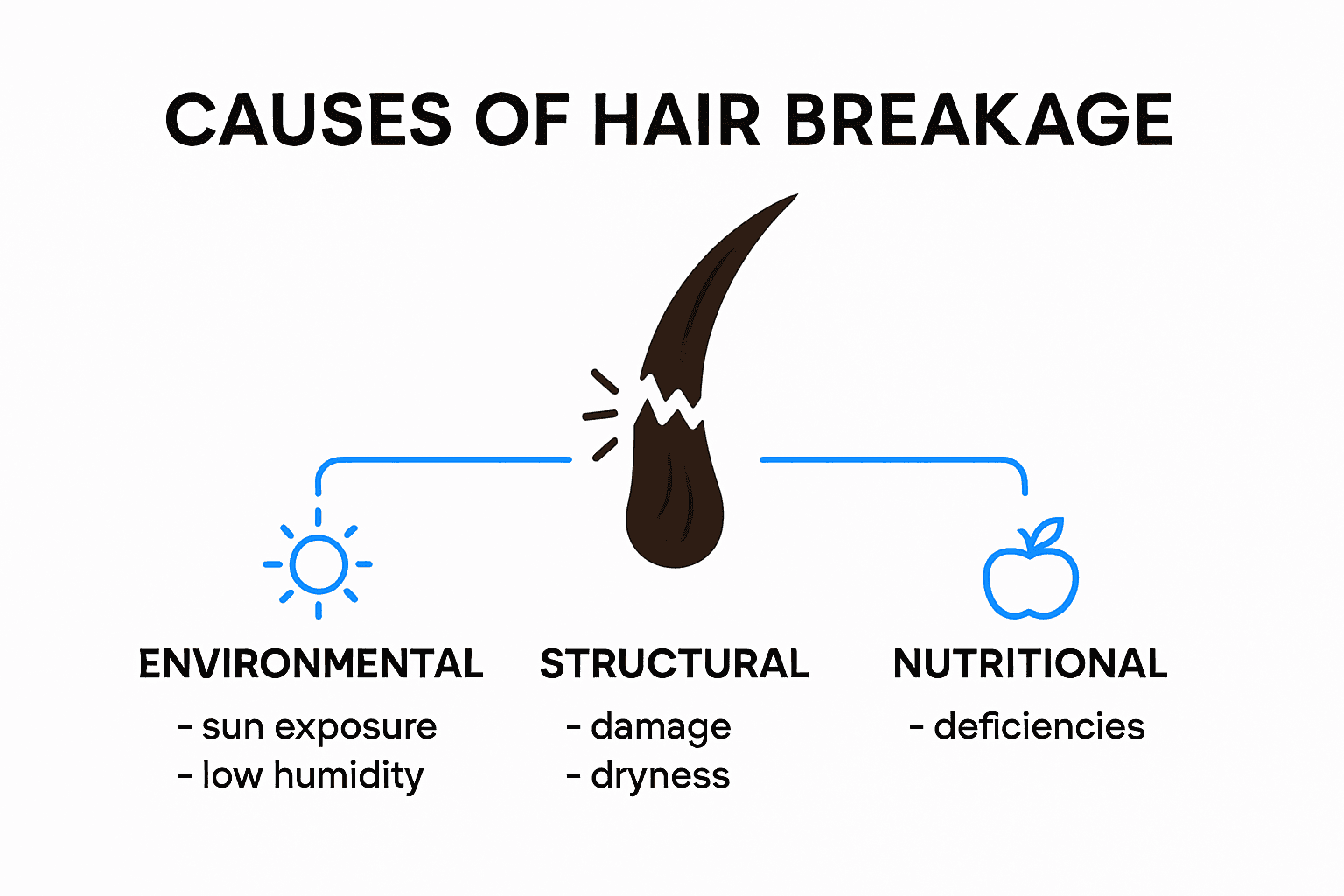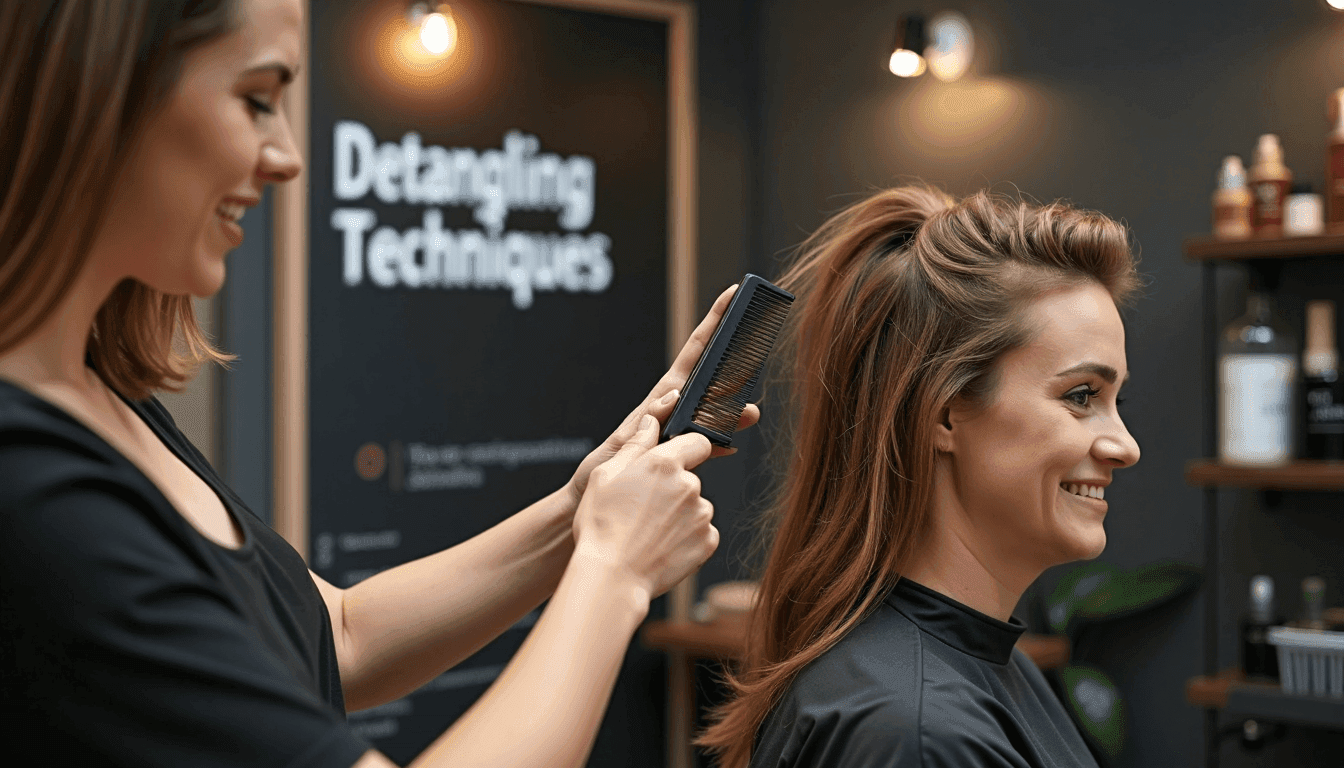Blog
Learning Materials
How to Fix Hair Breakage: Proven Solutions for 2025
Updated: July 7, 2025

Hair breakage leaves millions frustrated each year. Over 60 percent of people experience some form of hair damage due to styling, diet, or environmental stress. Here is the shocker. Most hair breakage is not caused by genetics or age. The real culprit is hidden in your daily habits and small choices you make without thinking.
Table of Contents
- Understanding Why Hair Breaks
- Everyday Habits To Fix Hair Breakage
- Personalized Hair Care For Faster Growth
- Choosing The Right Products And Tools
Quick Summary
| Takeaway | Explanation |
|---|---|
| Understand Hair Structure | Hair is composed of three layers, and damage to these layers, particularly from chemical treatments, can lead to breakage. |
| Mindful Hair Care Techniques | Use a wide-toothed comb to detangle gently, avoid brushing wet hair, and limit heat styling to minimize breakage. |
| Nutritional Health Matters | Ensure your diet includes sufficient protein, vitamins, and minerals essential for strong hair growth and resilience. |
| Personalized Hair Solutions | Leverage advanced diagnostic technologies for tailored hair care strategies that consider individual hair health needs. |
| Choose Appropriate Products | Select products with beneficial ingredients like keratin and avoid harsh sulfates, while using protective tools to reduce damage. |
Understanding Why Hair Breaks
Hair breakage is a complex problem rooted in multiple environmental and physiological factors that compromise your hair's structural integrity. Understanding these underlying causes is crucial for developing an effective strategy to fix hair breakage and maintain healthy hair.

The Structural Vulnerabilities of Hair
Hair is composed of a protein called keratin, which forms a delicate protein structure vulnerable to multiple types of damage. Each hair strand consists of three primary layers: the cuticle (outer protective layer), cortex (middle layer containing protein and pigment), and medulla (inner core). When these layers become compromised, hair becomes susceptible to breaking.
According to research from the Royal Society Publishing, chemical treatments like bleaching and perming can significantly disrupt the hair's protein structure. These processes weaken the protein bonds, making hair more fragile and prone to breakage. The structural damage occurs at a microscopic level, creating micro-fractures that gradually lead to visible hair damage.
Environmental and Lifestyle Factors
External factors play a significant role in hair breakage. Research from global dermatology networks indicates that exposure to ultraviolet (UV) radiation can oxidize structural proteins and lipids in hair, resulting in increased dryness and brittleness.
Additionally, mechanical stress contributes substantially to hair damage. Tight hairstyles create chronic tension on hair follicles, potentially leading to traction alopecia. Repetitive styling practices like tight ponytails, braids, and buns can cause gradual weakening of hair strands, making them more susceptible to breaking.
Nutritional and Internal Health Considerations
Nutritional deficiencies and internal health conditions can also significantly impact hair strength. Insufficient protein intake, low levels of essential vitamins like biotin, iron, and zinc, and hormonal imbalances can compromise hair's natural resilience. When your body lacks the necessary nutrients to support robust hair growth, the resulting hair strands become thinner and more fragile.
Metabolic disorders, thyroid conditions, and chronic stress can further exacerbate hair breakage by disrupting the natural hair growth cycle and weakening hair follicle health. This interconnection between internal health and hair quality underscores the importance of a holistic approach to managing hair breakage.
To truly address hair breakage, you need a comprehensive strategy that considers both external treatments and internal health support. Learn more about personalized hair care solutions that can help you develop a targeted approach to preventing and repairing hair damage.
To help clarify the main structural, environmental, and internal causes of hair breakage as discussed above, here is a table summarizing these factors and their effects:
| Cause of Hair Breakage | Examples | Effect on Hair |
|---|---|---|
| Structural Damage | Bleaching, perming, chemical treatments | Weakens protein bonds, increases fragility |
| Environmental Stress | UV exposure, dryness, pollution | Dries out hair, causes brittleness |
| Mechanical Stress | Tight hairstyles (ponytails, braids, buns) | Causes tension and strand breakage |
| Nutritional Deficiency | Low protein, biotin, iron, zinc | Thinner, more fragile hair |
| Internal Health Issues | Hormonal imbalance, metabolic or thyroid issues, chronic stress | Disrupts hair cycle, weakens follicles |
Everyday Habits to Fix Hair Breakage
Repairing and preventing hair breakage requires a strategic approach that integrates daily hair care practices and mindful lifestyle choices. By implementing targeted techniques and understanding how small changes can significantly impact hair health, you can transform your hair's resilience and appearance.
Gentle Handling and Detangling Techniques
The way you handle your hair plays a crucial role in preventing breakage. According to the American Academy of Dermatology, using a wide-toothed comb is essential for minimizing hair damage. Start detangling from the ends of your hair and work gradually upward, reducing stress on hair strands. This method prevents unnecessary pulling and reduces the risk of creating split ends or causing structural damage.
Avoid brushing wet hair, which is more vulnerable to breakage. Instead, use a soft microfiber towel to gently pat and absorb moisture, minimizing friction and potential damage. When possible, allow your hair to air dry or use the lowest heat setting on your hair dryer to reduce thermal stress.
Strategic Hair Styling and Protection

Heat styling tools can significantly contribute to hair breakage. Dermatology experts recommend limiting heat styling and always applying a heat protectant before using any thermal tools. Set styling tools to the lowest effective temperature and maintain a consistent distance to prevent direct, concentrated heat damage.
Choose hairstyles that minimize tension and stress on hair follicles. Avoid tight ponytails, braids, or buns that pull on your scalp. When using hair accessories, opt for soft scrunchies or fabric-covered elastic bands that reduce friction and potential breakage. Discover more about maintaining healthy hair styles with our comprehensive hair care guide.
Maintenance and Preventive Care
Regular maintenance is key to preventing hair breakage. Dermatology professionals suggest getting trims every 6 to 8 weeks to remove split ends before they travel up the hair shaft. This proactive approach helps maintain hair health and prevents further damage.
Nutrition also plays a critical role in hair strength. Ensure your diet includes proteins, vitamins (especially biotin), and minerals that support hair health. Stay hydrated and consider supplements that promote hair growth and resilience. Protect your hair from environmental stressors by using silk or satin pillowcases, which reduce friction during sleep.
By incorporating these everyday habits, you can significantly reduce hair breakage and promote healthier, stronger hair. Consistency is key. Small, deliberate changes in your hair care routine can yield substantial improvements in hair texture, strength, and overall appearance.
To make it easier to adopt the recommended habits for preventing hair breakage, here’s a table summarizing key daily practices, with their benefits and purpose:
| Habit | How to Practice | Benefit |
|---|---|---|
| Gentle Detangling | Use wide-toothed comb; start from ends and go upward | Reduces stress and breakage |
| Avoid Brushing Wet Hair | Pat dry with microfiber towel; air dry when possible | Minimizes friction and damage |
| Limit Heat Styling | Use heat protectant, lowest heat setting | Prevents thermal breakage |
| Choose Loose Hairstyles | Avoid tight ponytails, opt for soft scrunchies | Reduces tension on hair follicles |
| Regular Trims | Cut every 6–8 weeks | Removes split ends before worsening |
| Sleep on Silk or Satin Pillowcase | Use silk or satin instead of cotton | Minimizes overnight friction |
| Balanced Nutrition | Ensure adequate protein, vitamins, hydration | Supports strength from within |
Personalized Hair Care for Faster Growth
Personalized hair care represents a revolutionary approach to addressing individual hair health challenges, moving beyond one-size-fits-all solutions to targeted strategies that promote faster growth and reduce breakage. By leveraging advanced technologies and comprehensive analysis, individuals can now develop precise hair care routines tailored to their unique genetic, environmental, and physiological characteristics.
Advanced Diagnostic Technologies
Modern hair care has entered a new era of precision through AI-driven diagnostic technologies. According to recent market insights, artificial intelligence is transforming hair care by enabling virtual consultations and personalized product recommendations. These technologies analyze multiple factors including scalp condition, hair strand structure, genetic predispositions, and environmental influences to create customized treatment plans.
Noninvasive diagnostic tools now allow for detailed hair and scalp assessments. High-resolution microscopic imaging can reveal individual hair strand health, while advanced genetic testing provides insights into potential hereditary hair loss patterns. This granular understanding enables more targeted interventions that address specific hair growth challenges.
Innovative Treatment Approaches
Cutting-edge research is revolutionizing hair restoration and growth strategies. Studies on adipose-derived stem cells demonstrate promising results in hair follicle regeneration. These advanced therapeutic approaches focus on stimulating hair growth at the cellular level, offering hope for individuals struggling with persistent hair loss or slow growth.
Emergent technologies like nanocarrier drug delivery systems are enhancing treatment effectiveness. Follicular drug delivery research shows that targeted treatments can improve medication penetration into hair follicles, potentially accelerating hair growth and reducing breakage. These innovations represent a significant leap forward in personalized hair care solutions.
Holistic Personalization Strategies
True personalization extends beyond technological interventions. Explore our comprehensive hair growth guide to understand how nutrition, lifestyle, and targeted care interact to support optimal hair health. A holistic approach considers multiple factors including diet, stress levels, hormonal balance, and environmental conditions.
Nutrritional profiling now allows for precision supplementation that addresses individual deficiencies. Genetic testing can reveal specific nutritional needs that directly impact hair growth, enabling more targeted dietary recommendations. Personalized supplement regimens can be designed to address unique metabolic profiles, supporting hair strength from within.
The future of hair care is deeply personal. By combining advanced diagnostic technologies, innovative treatment approaches, and comprehensive lifestyle strategies, individuals can now access unprecedented levels of personalized hair health management. This approach not only addresses immediate concerns like breakage but also supports long-term hair growth and vitality.
Choosing the Right Products and Tools
Selecting appropriate hair care products and tools is crucial in preventing hair breakage and promoting healthy hair growth. The right selection can transform your hair care routine, providing protection, nourishment, and strength to minimize damage and support optimal hair health.
Understanding Product Ingredients
Not all hair care products are created equal. According to dermatological research, choosing products with specific ingredients can significantly reduce hair breakage. Look for formulations containing proteins like keratin, which help rebuild hair's structural integrity, and moisturizing agents such as ceramides and natural oils that prevent dryness and brittleness.
Avoid products with harsh sulfates, which can strip natural oils, and alcohol-based styling products that cause excessive dryness. Instead, prioritize products labeled as hydrating, repairing, or specifically designed for damaged hair. Pay attention to your hair's unique texture and porosity when selecting conditioners, leave-in treatments, and styling products.
Selecting Protective Hair Tools
Dermatology experts recommend using tools that minimize mechanical stress on hair strands. Invest in a wide-toothed comb or a brush with soft, flexible bristles to gently detangle hair without causing unnecessary breakage. When using heat styling tools, always apply a heat protectant spray that creates a protective barrier, reducing moisture loss and minimizing thermal damage.
Choose hair accessories that are gentle on hair, such as silk scrunchies or fabric-covered elastic bands. Avoid metal clips and tight hair ties that can cause tension and breakage. Learn more about protective styling techniques to support your hair's health and prevent damage.
Professional Tools and Maintenance
Investing in high-quality styling tools can make a significant difference in hair health. Look for hair dryers with multiple heat settings and ceramic or ionic technology, which distribute heat more evenly and reduce damage. Choose flat irons and curling wands with adjustable temperature controls, allowing you to select the lowest effective heat setting for your hair type.
Regular maintenance of your hair tools is equally important. Clean brushes and combs regularly to remove product buildup, and replace heat styling tools every few years to ensure they function optimally. Professional-grade tools often provide more consistent heat distribution and include advanced features that protect hair during styling.
By carefully selecting products and tools that support your hair's unique needs, you can significantly reduce breakage and promote healthier, stronger hair. Remember that prevention is always more effective than repair, so invest time in understanding your hair's specific requirements and choosing products that nourish and protect.
Frequently Asked Questions
What causes hair breakage?
Hair breakage can be caused by structural damage from chemical treatments, environmental stressors like UV exposure, mechanical stress from tight hairstyles, and nutritional deficiencies. These factors weaken the hair structure, making it prone to breakage.
How can I prevent hair breakage?
To prevent hair breakage, use gentle detangling techniques with a wide-toothed comb, avoid tight hairstyles, limit heat styling, and maintain regular trims. Additionally, ensure a balanced diet rich in proteins and essential vitamins to support hair health.
What products should I use for damaged hair?
Look for hair care products containing nourishing ingredients like keratin, ceramides, and natural oils. Avoid products with harsh sulfates and alcohol-based ingredients, as they can further dry out and damage the hair.
How often should I get trims to prevent split ends?
It’s recommended to get trims every 6 to 8 weeks to remove split ends before they worsen. Regular trims help maintain hair health and reduce the likelihood of breakage.
Ready to Stop Hair Breakage for Good?
You have just learned how everyday stress, poor handling, and hidden habits silently destroy your hair’s structure. If you feel frustrated by split ends and slow growth, you are not alone. The article discussed structural weaknesses, environmental challenges, and the struggle to find reliable, personalized advice for stronger hair. Now is the moment to move beyond generic tips and discover a solution built to understand your unique hair needs.

Take control with a tailored assessment at MyHair.ai. Upload a simple scan and receive AI-powered insights that track your hair’s progress, reveal breakage causes, and recommend the best products for renewed strength. Real change starts when you stop guessing and use smart, individualized tools. Ready to transform your hair journey? Visit MyHair.ai now and see which strategies really work for you. For practical tips on healthier styling and prevention, check out our comprehensive hair care guide.